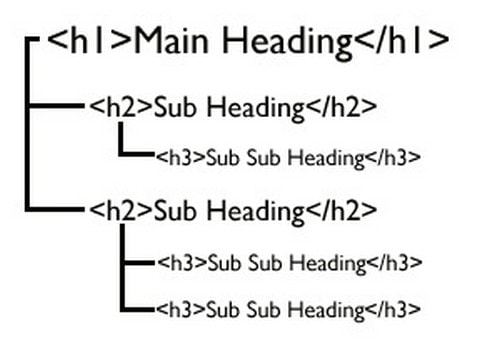
Analytica House
Şub 7, 2023Blog Yazılarında Başlık Hiyerarşisi Nasıl Oluşturulur?

“Bir sayfadaki metin söz konusu olduğunda, bir başlık gerçekten güçlü bir sinyaldir; bu bölümün bu konu hakkında olduğunu bize söyler.”[1] diyor Google Arama Savunucusu John Mueller. Ve haklı, ama dahası da var: Bir başlık yalnızca bize değil, aynı zamanda arama motorlarına da içeriğin konusunu iletir; bu da arama motoru sonuç sayfalarının üst sıralarında görme olasılığımızı belirler.
Açık bir başlık-alt başlık hiyerarşisi bir blog yazısında birkaç nedenle önemlidir. Öncelikle, içeriğin okuyucu için okunmasını ve anlaşılmasını kolaylaştırır. İyi yapılandırılmış bir başlık-alt başlık hiyerarşisi, içeriği daha küçük bölümlere ayırarak okuyucunun aradığı bilgiyi bulmasını ve yazının akışını takip etmesini kolaylaştırır. Ayrıca, arama motorlarının içeriği taramasına ve blog yazısının yapısını anlamasına yardımcı olur, bu da daha iyi arama motoru optimizasyonu (SEO) ve arama sonuçlarında daha fazla görünürlük sağlayabilir.
Başlık-Alt Başlık Hiyerarşisi Nedir?
Bir blog yazısı gibi yazılı bir belgedeki başlıkların ve alt başlıkların hiyerarşisi, içeriği bölümlere ayırmak ve okuyucuların anlamasını kolaylaştırmak için nasıl düzenlendiğini ifade eder.

Başlık
Bir belgedeki ana içerik bölümleri, her bölümde ele alınan konuların genel bir görünümünü sağlayan ana başlıklardır. Ana başlıkların amacı, içeriği yapılandırmak ve düzenlemek, okuyucuların belgenin akışını takip etmesini ve aradığı bilgiyi bulmasını kolaylaştırmaktır. Ayrıca arama motorlarının belgenin yapısını anlamasına yardımcı olurlar, bu da görünürlüğünü artırabilir. Kısacası, ana başlıklar başlık-alt başlık hiyerarşisinin önemli bir parçasıdır ve bir belgenin okunabilirliğini, düzenini ve bulunabilirliğini geliştirmede kritik rol oynar.
Alt Başlıklar
Alt başlıklar, bir belgenin içeriğinde ana başlıklara ek ayrıntı ve yapı sağlayan ikincil bölümlerdir. Genellikle ana başlıklarla aynı şekilde biçimlendirilirler, ancak daha küçük bir yazı tipi veya daha hafif bir ağırlıkla. Alt başlıklar, içeriği daha küçük ve yönetilebilir bölümlere ayırmak için kullanılır, bu da okuyucuların çeşitli bilgi parçaları arasındaki ilişkileri anlamasını kolaylaştırır.
Doğru Başlık-Alt Başlık Hiyerarşisini Kurmak
Açık bir başlık-alt başlık hiyerarşisi oluşturmak, bir belgenin yapısının dikkatli bir şekilde planlanmasını ve organize edilmesini gerektirir. Bunun için yazarın metnin kabaca bir taslağını oluşturması, metni anlamlı parçalara ayırmayı bilmesi ve alt başlıklara dahil edilecek uygun ifadeleri belirlemesi gerekir. Şimdi iyi organize edilmiş bir blog için neler yapılması gerektiğine daha yakından bakalım.
Yazmadan Önce
Yazmaya başlamadan önce, blog yazınızın yapısını tanımlamak, başlık ve alt başlıkların düzenli olmasını sağlamak için kritik öneme sahiptir. Bu aşama, ele almak istediğiniz ana konuların ana hatlarını belirlemeyi ve içeriği faydalı bölümlere ayırmayı içerir. Yazmaya başlamadan önce şu adımları gözden geçirdiğinizden emin olun:

- Şu soruları yanıtlayın: Vermek istediğiniz temel mesaj veya ana fikir nedir? Okuyucularınızın bu yazıdan ne öğrenmesini veya almasını istiyorsunuz?
- Kapsamak istediğiniz ana konuları belirleyin ve içeriğinizin temel amacına hangi konu veya alt konuların uygun olduğuna karar verin.
- Yapının mantıklı ve kolay takip edilir olmasını sağlayın: Başlıkların ve alt başlıkların mantıklı bir ilerleme izlemesini ve içeriğin okuyucuların kolayca anlayabileceği bölümlere ayrılmasını sağlayın.
- Ana bölümler için h2, daha küçük bölümler için h3, h4 vb. kullanın.
Açık ve tutarlı bir başlık-alt başlık biçimlendirmesi kullanmak, iyi bir hiyerarşi kurmak için önemlidir. Biçimlendirme, gövde metninden görsel olarak ayırt edilebilir ve belgenin tamamında tutarlı olmalıdır; böylece okuyucular başlıkları hızlıca fark edip yapıyı takip edebilir.
Tüm başlık ve alt başlıklar için aynı yazı tipi boyutu, kalınlığı ve stilini kullanın: Tutarlılık önemlidir, bu yüzden belgenin tamamında aynı biçimlendirmeyi koruyun.
Doğru HTML Etiketlerini Kullanmak
HTML’de başlıklar farklı seviye etiketlerle tanımlanır: h1, h2, h3 vb. Blog yazınızda başlık-alt başlık hiyerarşisini kurmak için doğru etiketi kullanmanız çok önemlidir.

- h1 etiketi: Bu etiket blog yazınızın ana başlığı için ayrılmıştır ve sayfada yalnızca bir kez kullanılmalıdır.
- h2 etiketi: Bu etiket yazınızın ana bölümleri için kullanılır. İçeriği ana bölümlere ayıran başlıklar için h2 etiketlerini kullanın.
- h3, h4 vb.: Bu etiketler içeriği daha küçük alt bölümlere ayırmak için kullanılır. İlk alt başlık seviyesi için h3, sonraki için h4 kullanın ve böyle devam edin.
Başlıkların Alaka Düzeyi
Başlıkların ve alt başlıkların, özetledikleri içeriğin amacı ve kavramıyla uyumlu olması kritik öneme sahiptir. Başlıklar ve alt başlıklar, içeriği doğru bir şekilde yansıtmalı ve okuyucunun mantıklı bir şekilde gezinmesine yardımcı olmalıdır.
Yazar, gövde metninde ifade edilen fikri birkaç kelimeyle aktarmalı ve bu kelimeleri alt başlığa dahil etmelidir. Ayrıca hem başlıkta hem de alt başlıklarda anahtar kelimeler kullanılmalıdır.
Başlık Hiyerarşisi ve SEO
Düzensiz, fikir akışı eksik olan içeriklere kıyasla iyi organize edilmiş bir blog yazısı, Google’ın tercih ettiği ve kullanıcılara sunduğu içerik türüdür. Çünkü başlıklar ve alt başlıklar yalnızca kullanıcılara değil, aynı zamanda arama motorlarına da içeriğin neyle ilgili olduğunu okumada ve anlamada yardımcı olur. Bu yüzden, kötü organize edilmiş bir blog yazısının SERP’te üst sıralarda yer alması şaşırtıcı değildir. Googlebot içeriği mantıksal akış ve okunabilirlik açısından yararsız bulursa, içerik arama sonuçlarında üst sıralarda listelenmez.
Başlıklarda ve Alt Başlıklarda Anahtar Kelimeler
Kullanıcıların ve arama motorlarının içeriği anlamasını kolaylaştıran kritik faktörlerden biri, alt başlıklarda anahtar kelime kullanımının doğru yapılmasıdır. Anahtar kelimeler, yalnızca gövde metinlerinde değil, başlıklarda ve alt başlıklarda da içerik yazarlarının kullanımına sunulmuştur.
Kaynaklar
- Search Engine Journal – On-Page SEO: Header Tags
- SEO Buddy – Headings and Subheadings
- ContentKing – Headings Guide
- Yoast – How to Use Headings on Your Site
More resources

ChatGPT Shopping Research Nedir? Nasıl Çalışır?
ChatGPT Shopping Research, kullanıcıların alışveriş araştırmalarını hızlandıran yapay zeka destekli...

Black Friday Sonrası Sadık Müşteri Kazanmak İçin Veri Tabanlı Taktikler
Sadık müşteri kazanımı, Black Friday sonrası dönemde e-ticaretin en stratejik hedeflerinden biridi...

Google MMM ile Satış Artışlarını Doğru Ölçmenin 5 Yolu
Google MMM (Marketing Mix Modeling), pazarlama karması modellemesi olarak bilinen bu yöntem, çerezsi...

